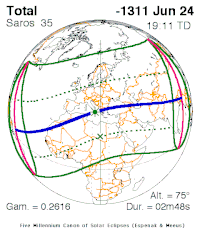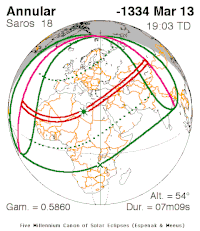



The possible solar eclipse mentioned in a text dating to the reign of Muršili II could be of great importance for the absolute chronology of the Hittite Empire within the chronology of the ancient Near East. The text records that in the tenth year of Mursili's reign, "the Sun gave a sign" (istanus sakiyahta), just as the king was about to launch a campaign against the Kingdom of Hayasa-Azzi in north-eastern Anatolia.[1]
The reference in the annals was first interpreted as describing an eclipse by Emil Forrer (1926),[2] Schorr (1928) identified it as the eclipse of the 13 March 1335 BC, visible as annular in Anatolia in the afternoon.[3]
It is now more commonly identified as the one of 24 June 1312 BC, which was visible in totality in northern Anatolia in the afternoon.[4] Paul Åström (1993) proposes the alternative date of 13 April 1308 BC, which would have been visible as a partial eclipse at sunrise. Peter J. Huber has suggested a date of 8 January 1340 BC.[5]
- ^ KUB XIV 4.24: [ma-a-an I-NA KUR A]zi-ma i-ia-ah-at nu dUTU-us sa-ki-ya-ah-ta "[When] I marched [to the land of A]zzi, the Sungod gave a sign." Theo P. J. Van Den Hout, The Purity of Kingship: An Edition of CTH 569 and Related Hittite Oracle Inquiries of Tutẖaliya (1998), 42f.
- ^ E. Forrer, Forschungen II 1.1 "Astronomische Festlegung des Soppiluljomas, Morsilis und Amenophis IV." (1926) KUB XIV,4 (= CTH 70).
- ^ Astronomische Abhandlungen 8–9 (1929), p. 16. Mitteilungen des Instituts für Orientforschung 6 (1958), 188.
- ^ Bryce (1998)[page needed]
- ^ Huber, Peter J. (2001). "The Solar Omen of Muršili II". Journal of the American Oriental Society. 121 (4): 640–644. doi:10.2307/606505. JSTOR 606505.